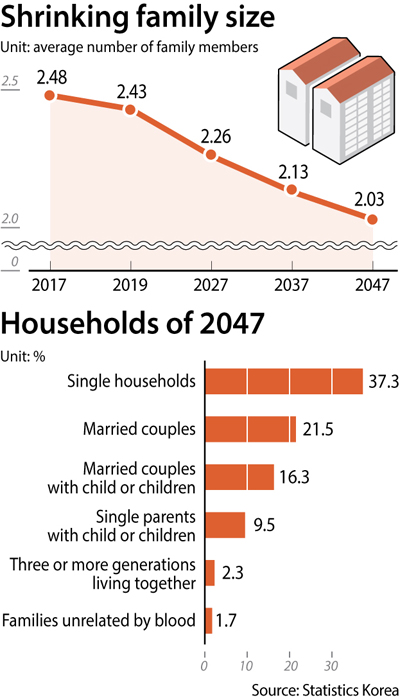Households of the future will be very single

Statistics Korea on Friday released a report “Population Projections for Provinces” that included estimations of the households of the future: their size, type and structure. The report, which is drawn up every five years, was actually released three years ahead of schedule as projections have been drastically changed.
According to the report, Korea’s total number of households, which was 19.57 million as of 2017, will reach a peak of 22.65 million in 2040. Then they will steadily decline, shrinking to 22.3 million units in 2047. Though the total number of households will experience ups and downs - due largely to the increase in the number of single households - the average family size will shrink from 2.48 in 2017 to 2.03 in 2047.
The number of single households is increasing at a formidable speed. Typically, single families signify an unmarried or divorced person or a widow or widower. In 2017, non-single families living together accounted for 69.9 percent of total households. They included households composed of couples with a child or children (31.4 percent), couples without children (15.8 percent) and single parents with a child or children (10.2 percent).
Single families only accounted for 28.5 percent.
In 2047, however, non-single families are expected to shrink to 61 percent and single families are estimated to grow to 37.3 percent.
“In 2047, single households will become the most dominant type of households in every city and province,” said Kim Jin, a director at Statistics Korea.
To zoom in on individual areas, the ratio of single households will surpass 40 percent in seven cities and provinces, including Gangwon (41.9 percent), North Chungcheong (41.8 percent), Daejeon (41.7 percent), South Chungcheong (40.6 percent), North Jeolla (40.5 percent) and North Gyeongsang (40.2 percent).
The average household size is expected to shrink below two in nine cities and provinces including Gangwon (1.86), South Jeolla (1.9), North Gyeongsang (1.91), Busan (1.94) and Daejeon (1.99).
A steady increase in the number of households consisting of childless couples will take place. They accounted for 15.8 percent of total households in 2017, which is expected to increase to 21.5 percent by 2047. Households that consist of parents and a child or children are expected to drop below 20 percent of total household units in 2047 except in Sejong, which is expected to maintain 22 percent.
Women are increasingly becoming main providers for families. Households supported by a female provider, which stood at 30.4 percent at 2017, are expected to reach 39.2 percent of total households by 2047. In other words, four out of 10 households will have female providers.
“President Moon ordered his staff to ‘come up with comprehensive policies for single households,’ calling for changes in housing and social welfare policies currently focused on families of four in the face of rapid increase of single households,” said presidential spokeswoman Ko Min-jung last Friday.
BY KIM KI-HWAN [kim.byungwook@joongang.co.kr]










with the Korea JoongAng Daily
To write comments, please log in to one of the accounts.
Standards Board Policy (0/250자)